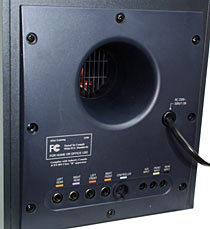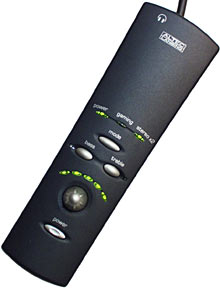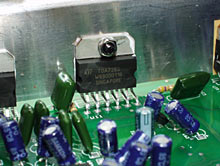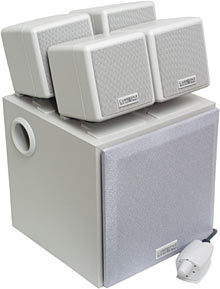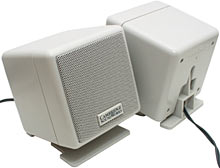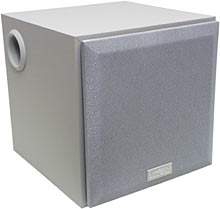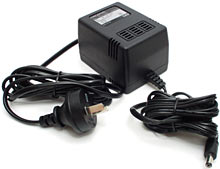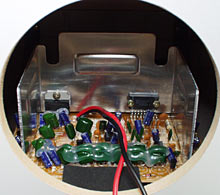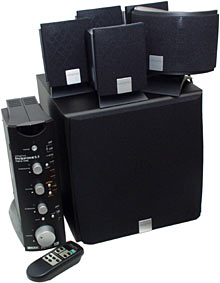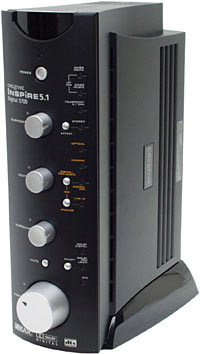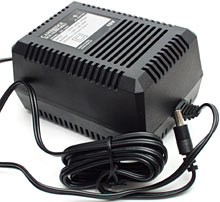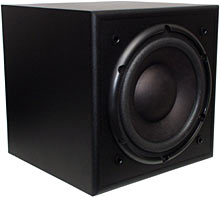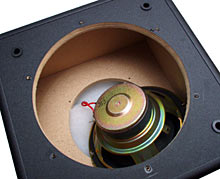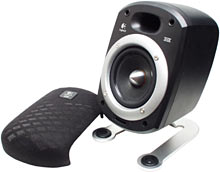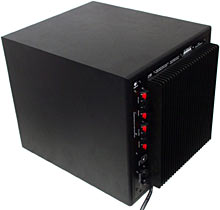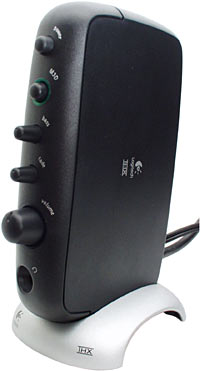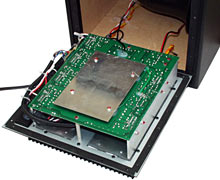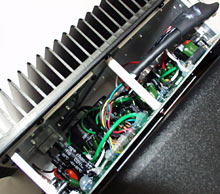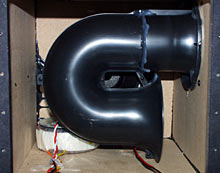
Multimedia speaker comparison: Altec Lansing Select 4100, Cambridge SoundWorks FPS1600, Creative Inspire Digital 5700 and Logitech Z-560
Review date: 12 January 2002. Last modified 03-Dec-2011.
The average quality of computer speaker systems is improving.
That's not saying much. It couldn't get much worse.
It's always been possible to connect a really good sound system to a PC - well, to any PC with sound hardware beyond the PC speaker, anyway. Since all PC sound cards have a normal unbalanced one-stereo-pair line level output, you can just plug 'em straight into a stereo, home theatre or PA system of arbitrary gruntiness, and you're away.
People don't generally do that, though. People generally plug in little dinky plastic speakers, instead. These usually have their own teeny amplifier built in, and they usually sound like a transistor radio falling down a drainpipe.
I exaggerate. Slightly.
Nowadays, though, sound cards with four (or more) channel output are dirt cheap. Games can use multi-channel surround sound, and it's pretty easy to convert a PC into an OK DVD player with surround output of various flavours. Even if all you want to do is play CDs and/or MP3s on your PC, a decent speaker system is obviously desirable.
Accordingly, more and more people are buying fancier "multimedia" speaker systems.
The basic kind of half-decent PC speaker system is the "2.1" channel setup, with two mid-to-high-frequency satellite speakers and one larger subwoofer - the ".1" part, since it's bass-only. Putting the (comparatively) big bass driver in a separate box lets you keep the total speaker system size down, since the satellites can stay pretty weedy; bass is non-directional, so it's OK to have just one bass speaker. Well, that's the theory, anyway.
For multi-channel audio you need a couple of surround speakers as well, making a 4.1 channel system; for full home theatre with a centre front speaker as well, the term is 5.1 channel.
Subwoofers are meant to be what the name suggests - below a woofer, and dealing only with the really low bass. Certainly below 80Hz (cycles per second) and probably below 40Hz. Once you're down below 40Hz, you're actually rather deeper than you need, for a lot of program material. A great deal of music doesn't have any bass to speak of below about 60Hz, and most listening rooms are small enough that you need amazing amounts of power and/or a very efficient sub to get a decent amount of audio energy into the air at that frequency.
30Hz sound waves are more than 11 metres long; if your listening room is considerably smaller than that in all dimensions (which it probably is) then you're pushing fertiliser uphill if you want high output at that frequency.
Never mind that if you're shopping for a multimedia speaker system, though, because their "subwoofers" are almost without exception nothing like as beefy as a "proper" sub. They typically use five or six inch "drivers" (the actual round electromechanical transducer things that make the noise), in some kind of ported cabinet (not just a sealed box) that gives them reasonable efficiency (amount of noise per unit power). These high-efficiency ported enclosures also, however, have a hefty hump in their efficiency curve in some reasonably bass-ish region of the frequency axis; the higher the hump is and the lower the frequency it occurs at, the "bassier" the little sub will sound. A really high resonance peak, though, will drown out other frequencies; the sub will resonate like a drum, and sound very crummy.
The drivers in small subs aren't likely to have an intrinsic resonance below about 60Hz, and may only manage 80Hz or more. Middle C is 261Hz (or so; it varies with the tuning of your instrument), and every octave is a factor-of-two frequency change, so 65Hz is only a couple of octaves below middle C. That's not exactly subterranean bass; normal pianos go an octave and a bit lower.
It's really, really difficult to get worthwhile response out of any speaker much below the resonance of the bass driver it uses, so 50Hz response, at best, is all you can reasonably expect from pretty much any multimedia speaker subwoofers. The small speaker boxes count against these subs as well; all things being equal, the smaller the box, the lousier the bass response.
As if that's not enough, these "subwoofers" often have to work as midrange speakers as well, because they're teamed up with really tiny satellite speakers which have a hard time playing anything below about 200Hz. Getting response up to, and past, 200Hz out of a six inch bass driver is easy. But if you do it, you end up with a subwoofer whose location is obvious, because it's not playing bass and nothing else. Because real bass is non-directional, a properly set up subwoofer can't be located by ear. If the sub has to play higher frequencies, though, it becomes much harder to get yourself a good stereo soundstage.
Fortunately, as demonstrated by the popularity of horrible little two-box speaker systems, most multimedia speaker buyers are... what's that euphemism for "cloth-eared gits", again... oh yes, "non-critical listeners".
Everybody's a non-critical listener when they're not really paying attention to whatever sounds are being played at them. If you're a non-critical listener all of the time, though, you're lucky. You don't need a fancy speaker system. Anything that doesn't catch fire will do.
This may rule out the very cheapest 2.1 channel systems, but there are still lots of options.
If you're a critical listener but you don't need a speaker system that buzzes your booty, just buy yourself a good pair of headphones. Allow me to recommend Sennheiser's HD-590s. If you're into games with 3D positional audio, you don't need multiple speakers for accurate sound location spotting; two headphone transducers will work better. You only have two ears, after all.
If you want to feel the action as much as hear it, though, headphones are no good. And they're also unhelpful if you want to engage in social movie viewing.
There is, therefore, definitely good reason for many people to buy a multi-channel speaker system.
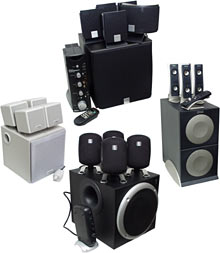
And I've checked out a few recent offerings.
Altec Lansing Select 4100
For a list price of $AU399, Altec Lansing's Select 4100 4.1 Speaker System is well above the price of the entry-level Taiwanese cheapies. It's also obviously superior, if all you care about is looks (see "non-critical listeners", above). Mind you, the 4100's supposed to deliver "the optimum in 4-channel sound performance", too.
The weirdest thing about the 4100 system is the satellite speakers. They're officially specified as being 2.25 inches wide by 2.5 inches deep by 7.3 inches high (57 by 63.5 by 185.5mm), but they're actually even smaller than that suggests; if you don't count the plinths at the bottom, these things are only about 30mm deep. The shiny parts are cast aluminium, and the sats feel very solid. Unfortunately, they also fall over backwards rather easily, because the plinths don't extend much behind their Z-axis centre of gravity. But one suffers for one's art.
There isn't a lot of room for drivers in satellites this skinny, so Altec Lansing have used these one inch "Micro Drivers", with aluminium dish-cones, a cloth roll surround that gives them more fore-and-aft movement capability than most tiny drivers, and a swish looking plastic bar across the front of each driver to protect it from damage.
The result is, definitely, one cool looking little speaker. It's also a speaker that really can't reproduce anything from medium-midrange on down, though. These satellites lean on the subwoofer more than usual.
The Select 4100 system subwoofer's a medium sized unit (8.5 inches wide, 12.5 inches deep, 14 inches high; 216 by 317.5 by 355.5mm) with a pair of forward-firing 5.25 inch drivers (when you've only got a little sub, every quarter inch counts) and a rear-facing port.
The back of the sub has all of the connectors, and the mains power cable. The speaker terminals are somewhat downmarket RCA connectors; the speaker leads are permanently attached to the satellites at the other end.
RCAs are OK for lower powered systems like this, provided you don't get your cables confused and connect some other gadget's line level to the speaker level output; that can barbecue the other widget.
Apart from that, RCAs are simple to connect and make it impossible to wire speakers backwards; positive and negative always end up in the right place. But simple spring terminals are better if you want to be able to extend the cables.
Hooking up the 4100's speakers is easy enough, as long as you don't expect Altec Lansing's colour coding of the connectors to help you. OK, I suppose they couldn't use green, blue or pink, on the grounds that those are standard "PC99" colours used for sound card connectors, these days. But they instead settled on purple, orange, brown and "gold", with a little block of each colour printed above each connector; to my eyes the last three look like three different shades of tan. In good light, for someone with good colour vision, it's not likely to be a problem. Since you're more likely to be plugging this thing together under your desk, though, the colour coding is of questionable value.
You get a funky remote control with the 4100 system, as well. It's a wired remote, and connects to the subwoofer with a single thick-ish cable. For desktop use you can hook the remote into a weighty aluminium stand; if you want to hand-hold it, you can unhook it. There are no controls anywhere else; it's all done with the remote.
Mind you, there's not that much you can do. There's "gaming" mode, in which the front and rear stereo inputs each come out of the satellite pair you'd expect, with the bass from both inputs sent to the sub.
If you're only using the front input but still want all four satellite speakers to work, you use "stereo X2" mode, which duplicates the front input to the rear as well.
There's bass, treble and volume adjustment, too, all done with the no-end-stops digital knob on the remote. And that's it for the controls.
The Select 4100 also has an auxiliary input, but that just sits on top of the front stereo pair; it can't be selected separately. More usefully, there's a headphone socket as well; it's on the top of the remote, next to the cable entry point. Plugging in 'phones mutes the speakers.
The remote is replete with green LEDs, under neat oval lenses.
Inside the 4100 subwoofer there's a pretty typical scene. One short flared port - the trumpet-like ends of the port help minimise air turbulence, which can create unpleasant noises. A few amplifier chips bolted onto a good-sized heat sink; the sink's entirely inside the box and so doesn't get a lot of cooling air flow, but it's big enough that overheating shouldn't be an issue. Cable ties and hot-melt glue blobs prevent wires from buzzing against other components, and keep plugs and sockets mated. The discrete components on the circuit board don't quite seem to have been put there by a neatness freak, but it works. It'll do.
There's no acoustic damping material inside this subwoofer. A wad of sound-absorbing stuff - polyester fibre, usually, in modern speakers - strategically placed in a speaker will damp out unwanted box resonances, and also make the box acoustically larger by slowing down the sound waves. It'll also reduce the efficiency of the speaker, though. And it could lead to overheating of internal amplifiers. And it's not free. So un-lagged designs are common among computer speakers, and this is one of them.
The 4100's powered by three ST Microelectronics TDA7265 amp chips, each good for 25+25W stereo output if you're mean to them and have a beefy enough power supply, or rather less if you're not, and you don't.
The drivers in the subwoofer aren't magnetically shielded - not a very big deal unless you for some reason have to put the sub next to your monitor.
Most speakers have a power rating printed on the back; these ones don't. Judging by the size of the magnet assembly, though, the 35 watt RMS rating of the subwoofer's not entirely unrealistic. That doesn't mean it's being sent that much power, but it could probably handle it without dying.
The satellite speakers are rated at 7 watts each, for a total system power of 70 watts RMS (OK, 71, but no doubt someone's rounding off somewhere). There's also, however, the Select 2100, a 2.1 channel version of the 4100, with no headphone socket or aux connector and with a simpler remote, which only lists for $AU249. The 2100's only rated at 26 watts RMS, which doesn't quite add up. I presume it's just got fewer amp chips in there, and a dinkier power supply for them.
In listening tests, the 4100 subwoofer showed a substantial in-room response peak well above 100Hz (which is not the dominant native resonance of this room) and dropped off from there, ending up not-too-useful below 75Hz. That's pretty good performance for a sub this size; you can't expect drink-spilling bass from five-and-a-bit-inch drivers.
I flung a selection of different music at all of the speakers in this comparison; among other things, each of them got to take a swing at Talking Heads' "Burning Down The House", Vivaldi's "Four Seasons", and a large-organ rendition of J.S. Bach's "Toccata and Fugue in D Minor".
Talking Heads were never afraid of bass, and Burning Down The House is actually likely to be about the bassiest track that most stereos ever have to play, provided their owner isn't into boom-car music created by people whose middle name is, literally, "Bass". The peculiar pumping bassline in this track is particularly mean to inadequate speakers turned up too far, so it's excellent test music.
For this track, the Altec Lansing sub certainly didn't give the bass the window-popping power it ought to have, but neither did it make any awful noises. Plenty of people have damaged the voice coils of lousy speakers trying to get the right kicked-in-the-kidneys feel out of them for music like this; the 4100 sub doesn't overstretch itself.
The weeny drivers in the satellites kept up OK with the sub; they're not the crispest small speakers I've ever heard, but minor bass and treble tweaking lets you attain a pleasing balance. And the whole system managed to play more than acceptably loudly. Well, loudly enough for any normal computer room, anyway; you can't expect a computer speaker system to manage rockin' party volume levels.
The Toccata and Fugue in D Minor, BWV 565, often referred to by people who wouldn't know a Bach Werke Verzeichnis number if it danced on their desk wearing lederhosen as just plain "Toccata", played on a big ol' organ by a typically reticent organist, is actually less of a bass test than the Talking Heads track. But to do thud and blunder pipe organ music justice, you need the ability to move a lot of air, and small subwoofers don't have that ability. So, once again, the Altec Lansing system didn't shake the floor much. But it didn't buzz or rattle either, and the satellites remained OK.
Deleting bass from the equation by switching to light and airy Vivaldi emphasised the fact that this "subwoofer" is playing plenty of midrange, but that's a standard problem of every multimedia speaker system I've seen. And despite the tiny drivers in the satellites, the 4100 sub doesn't seem to have a worse case of midrange-itis than the average.
For fine musical detail, I'm not in love with the 4100's satellites; they're not rubbish, but I've heard plenty of super-cheapo satellites that're no worse. Need bigger drivers. Need more midrange.
Getting away from critical listening, the 4100 system's performance for games was fine. Many games don't actually have a lot of super-low bass, because it sounds lousy through the crummy speaker systems that most people use. Accordingly, a somewhat above average subwoofer like this one is likely to sound A-OK, and it does.
I wouldn't be surprised if Altec Lansing have given the 4100's sub channel a bandpass filter, instead of just a low-pass one; when there actually is really low bass in the input signal, I think the pre-amplifier's just throwing it away, and benefiting considerably as a result. That's the way all sensible speakers should behave, but a lot of cheap computer subs just let everything through, whether they've got a hope of playing it or not.
The Select 4100's a pleasing enough system, but it's not super-cheap. If you only need stereo and not surround, and if you want a funkalicious-looking set of speakers for your office's show-off front desk, or indeed for the computer desk visible through the vast picture window of your obnoxiously bourgeoise residence, the cheaper 2100 could be it. But if you're not already totally sold on the look of these systems, the sound's unlikely to change your mind.
Cambridge SoundWorks FourPointSurround FPS1600
Into the bargain bin we go.
Creative/Cambridge SoundWorks' FPS1600 4.1 channel system is simple, straightforward, unpretentious and cheap.
Aus PC Market used to sell the the FPS1600 for $AU220, however they no longer stock it (click here to see their current case-related products). The prices I've got for the other speakers are full list from the manufacturers, not street; you can reasonably expect them to be a decent amount cheaper from many retailers, especially if you can stand to wait a little while. But even taking this into account, none of the other systems are going to be as cheap as the FPS1600.
If you're in the States, various dealers already list the FPS1600 for less than $US60. Can't complain about that.
When you're dealing with a "budget" 4.1 system, you have to make allowances. Creative's expensive Inspire 5700 (see below) gets no such charity, but at less than a quarter of the price, you can't expect too much from the FPS1600.
The FPS1600 satellites are very basic. Small plastic boxes. Slide-in stands. Wire. Sound, for the reproducing of, four. They're 89mm (3.5 inch) cubes not including the stands, and they should be easy to fit into all but the most gadget-packed computer room.
The satellites can't be dismantled without the assistance of a hacksaw, but peering through the grille reveals that they contain a driver that might qualify as a 2.5 incher, with a following wind. That's about as big a transducer as you could fit into such little boxes, and it bodes well. There might even be some damping material in there, too. Who knows.
This is not what you'd call a humungous subwoofer, either. It's almost exactly cubic, and 189 by 189 by 190mm (about 7.5 inches each way), so you couldn't possibly wedge a driver much bigger than six inches in diameter into it.
What it's got is a five incher, if you measure from the edges of its pressed-steel basket. The actual piston diameter's more like four inches. Little box, little speaker. Fair enough.
Possibly the most basic remote control you'll ever see.
The FPS1600 wired remote has just this one knob, but it's switched; turn it all the way down and you turn the speakers off. The remote slides into a little plastic doohickey which can be attached with provided double-sided tape to anything you like.
The connectors on the back of the FPS1600 sub are more simple 1/8th inch stereo jacks for input and RCA sockets for speakers. There's a mini-DIN plug for the remote control, a DC input connector, and a knob to set the bass level.
There's no channel-mixing control provided, but the FPS1600 pre-amplifier still lets you do four speaker output from a single stereo-pair input; if you've only connected the "front" input, all four satellites get the signal. Connect the other input and you'll only hear from the rear satellites if there's a signal going to the rear input.
The whole thing runs from an outboard 12 volt power supply with a 2.9 amp rating, which means the FPS1600 can't possibly have more than about 35 watts of output power. 30 watts, at most, is likely to be more like it. With reasonable efficiency, though, this is plenty; efficiency is more important than power handling in speaker systems.
Ten watts only sounds twice as loud as one watt, but an efficient speaker can sound much louder than an inefficient one from the same modest power input. Most listening's done at only a few watts, so modest power output isn't anything awful.
The little woofer in the FPS1600 sub has a 20 watt rating - and maybe it can even be sent that much power by the amplifier. The only unusual thing about this driver is that although it's magnetically shielded and thus safe to use next to a CRT monitor, it lacks the metal cap on the back that most such drivers have, so you can see the simple way in which the shielding's done. That's a second, smaller magnet stuck on the rear pole piece of the actual voice coil magnet; it's turned around so that the two magnets repel each other, and the result is a somewhat convoluted but smaller than normal external magnetic field.
Creative quote halfway plausible power numbers for the FPS1600 - six watts per satellite, 17 watts for the sub, at a rather obnoxious 10% total harmonic distortion. That adds up to more than six watts more than the power brick's rating, but I've seen much greater... optimism... from makers of small speakers.
Peer inside the FPS1600 sub and you see a box which is, proportionally speaking, closer to being filled with electronics than most. There's another internal heat sink, and more hot-melt glue encouraging components to stay where they are.
The only amp chip I could find without breaking out the tenon saw was this Philips TDA8511J, a four-channel amplifier that's presumably driving the satellite speakers and which has a redline output power of 13 watts per channel, into two ohm loads and from a 15 volt supply. Here, it's feeding four ohm speakers (I couldn't get into the satellites to look for impedance figures on the backs of the drivers, but Mister Multimeter worked just as well) from 12 volts, so it's probably good for about four and a half watts per channel. That'll do fine.
In listening tests, the FPS1600 subwoofer was obviously inferior to the Altec Lansing Select 4100 sub. The satellites, however, were about as nice-sounding as the Altec Lansing ones, if not better. I wouldn't complain about that, if I were you. Whaddaya want for $AU220 delivered?
The sub has a resonance peak around the 110 to 120Hz mark, and drops off smoothly below that, for the sort of frankly lousy low-bass response that I've come to expect from very small subwoofers.
One area in which this subwoofer, unfortunately, excels, is port noise. If you try to get phat bass by winding up the sub level control, what you'll actually get is a really intrusive response peak around the little sub's resonance, and a ton of obnoxious "chuffing" noises from the small, sharp-edged port. Small sharp ports act like a poorly engineered whistle when you move too much air through them.
It's quite easy to get the FPS1600 sub to make these noises, and they're annoying. You can minimise their audibility by setting up the sub so that the port faces away from you, and preferably towards something that isn't acoustically reflective. Don't put the port hard up against anything, though; that'll foul up the box tuning and eat most of the bass.
No matter what you do, for any significant volume level, you're unlikely to get away with setting the FPS1600's sub level knob above the half-way mark.
Burning Down The House's bass was... well, it was there, kinda, I guess, as long as I stuck to moderate volume levels. The sub was waving a little "Here I am!" flag in the low midrange, because that was about all it was playing, but careful positioning can minimise that. It was listenable. I didn't hate it.
For organ music, the FPS1600 sub gave it the ol' college try, but the floorboards weren't moving. The sub wasn't begging for death, either, mind you, as long as I was kind to it by keeping the volume down to sub-party levels.
Again, though, it really didn't stink. It was sort of like listening to an organ recital from outside the cathedral, through an open window. But it wasn't like listening to one from the basement, or the top of the belltower. And the dead simple unprocessed all-four-satellites playback style's perfectly adequate for music like this, which is meant to envelop you.
For light classical music, the cheapo FPS1600 satellites didn't disgrace themselves at all. An amazing sonic revelation it wasn't, but neither did the little cubic sats honk or whine at me. The sub location was pretty obvious, again, because it was handling a chunk of midrange. But that's a problem that the more expensive multimedia systems have too.
If you want maximum bass kick for your game playing, though, the FPS1600 ain't gonna give it to you. The satellites sound perfectly fine for the money, but the sub is just a little tacker.
The resonance hump of this little sub makes it an excellent object lesson in the limitations of really small bass boxes. There are about three bass notes that this sub'll play really loudly; anything higher it can play acceptably, anything lower fades away to nothing. This is an inescapable result of tuning a tiny box to produce something resembling real bass; you end up with a response curve that looks like a kiddy slide, with the peak sitting as low as the designers could get it, but seldom below about 80Hz, and commonly around 100Hz for truly small "subwoofers" like this one.
But, for the money, I like the FPS1600. It's cheap and cheerful, its remote volume control is handy, it looks nice, and it really doesn't sound that bad. If you're on a budget but want surround sound, check it out.
Creative Inspire 5.1 Digital 5700
And now, at the other end of the spectrum, Creative's show-off speaker system, the Inspire 5700.
At $AU899 non-delivered list price, this is not a cheap noisemaker. It is, in fact, expensive enough to be competing with real basic home theatre gear - not just all-in-one midi systems with surround speakers, but proper stand-alone surround amplifiers. You can't get a whole new quality surround system for $AU899 new, but you can get a new surround amp and cheapo used speakers; five anything-speakers from The Decade Taste Forgot will probably still sound better than any tiny multimedia speaker, and will tide you over until you can afford something better. The Inspire 5700 system has one-box convenience in its favour, but it'd better have something more as well, if it wants to mix it with the big boys.
The 5700's feature list is certainly complete. Full 5.1 channel operation, digital inputs, compatibility with various surround encoding modes, wireless remote, partridge, pear tree.
It's all built around this control box...
...which features an imposing collection of connectors on the back.
There are six RCA connectors for the speakers - not very professional-looking, Creative - but things get better from there. You get front and rear 1/8th inch stereo plug inputs, but you also get one of Creative's proprietary Digital DIN inputs (non-Sound Blaster users need not apply), plus standard electrical and optical S/PDIF digital inputs. And, impressively, you can hook up sources to every input and switch between them as you like. And all of the cables are included, too.
Use any of the digital inputs to feed the Inspire 5700 a Dolby Digital, DTS or Dolby Pro Logic encoded surround signal and it'll automatically detect it and enable that mode. You can do Pro Logic through the analogue input as well, but then you have to press a button to enable it.
The last two connectors on the back panel are a standard subwoofer line out in case you want to upgrade the provided sub, and a power input jack. That's there because...
...this system, despite its premium price, runs from a lump-in-a-wire power supply, just like the little FPS1600.
Since this 15 volt power brick is clearly labelled with its four amp, 60 volt-amp maximum rating, there's no way this system can actually be outputting more than 60 watts at any given moment, unless the power supply rating is conservative or the amplifier efficiency is over one hundred percent. In which case Inspire 5700 amplifiers can solve all of the world's energy problems.
Creative, however, claim the sub's good for 30 watts, with another 21 from the centre speaker and seven watts each from the satellites, giving a total of 79 watts. Ah well. As explained above, power overstatements aren't exactly a Big Lie.
You get a little infra-red remote control with the Inspire 5700 that can control every feature except the sub, centre and surround levels. The volume knob on the control box is motorised, so it turns in response to remote input.
The 5700 satellite speakers are little oblong things about 92 by 92 by 112mm (3.6 by 3.6 by 4.4 inches) in size; the curved-front centre speaker's larger - 89 by 166 by 108mm (3.5 by 6.5 by 4.25 inches). The satellites contain weeny little two-and-a-bit-inch drivers, but there's a mighty 2.5 incher in the centre speaker. You get five springy little plastic stands for the small speakers, but there's also an extra angled one for the centre speaker which you can use if you're putting it on top of a monitor and want it to point down at your face.
Inside the small speakers is, wonder of wonders, a bit of acetate fibre wadding, and drivers rated at 10 watts RMS for the satellites and 12 watts for the centre speaker.
The Inspire 5700 subwoofer's a beefy looking unit, 284 by 262 by 264mm in size (11.2 by 10.3 by 10.4 inches). Remove its grille and you see an apparently very serious eight inch driver.
But something is amiss. This thing doesn't weigh enough. OK, the amplifier hardware's in the control box, not in the sub, but shouldn't there be a big heavy magnet on the back of that big show-off cone?
Well, no. The eight inch cone on the front of the Inspire subwoofer isn't actually a speaker driver - it's a passive radiator, which has some of the qualities of a speaker and some of the qualities of a port. Basically, it's a speaker cone and roll surround, without any electromagnetic components on the back of it. Behind the radiator is an empty sealed sub-chamber taking up about half of the subwoofer's volume, and on the back wall of that chamber there's a six inch (to be charitable) driver. The back wall of the passive radiator chamber is the front wall of the smaller bass driver's own sealed sub-enclosure, which is packed with fluffy wadding.
Creative call this design "Symmetrically Loaded Acoustic Module" or "SLAM", and they have lots to say about how way-cool this technology is supposed to be. Every other speaker maker says similar things about their own fancy-acronymed speaker designs, though; sensible customers are now justly skeptical about each new Binaurally Integrated Giga-Bass Acoustic Linear Loading System (BIGBALLS) innovation.
Creative claim a modest 30 watt power rating for the subwoofer, but the printing on the back of the six inch driver is even more modest; it's a 20 watt unit. The centre speaker's meant to be 21 watts, but the back of the driver says 12; you can maybe get a bit more through it by feeding it only frequencies that it can easily handle (which is what all good sub-sat systems should do), but 21 watts is still stretching it. Mind you, the satellites are only rated by Creative at seven watts each, but they've got 10 watt rated drivers. Maybe they're only driven by seven watt amplifier channels.
Never mind the power numbers; the Creative rig has good enough efficiency to play louder than you're likely to want in the average computer room. If you want a real nightclub deafening then you're going to have to pay more for a real hi-fi system, but as computer speakers go, these are loud ones.
Despite the system's complexity, it's also quite easy to set up and tweak. There's a basic test mode that plays white noise through each of the six channels in turn, but that's not good for much beyond making sure that everything's plugged in and sitting in the right place. More usefully, the separate subwoofer, centre and surround level knobs on the control box make it easy to get the respective levels set up properly.
If you're listening to a plain stereo source, the Inspire 5700 lets you hear it "dry", through the front speakers and sub only, with or without the centre speaker contributing, depending on whether you turn the centre level down or not. If you want surround added to your stereo, you can turn on one of two Creative Multi Speaker Surround (CMSS) "upmix" modes. These modes synthesise surround sound with or without lots of movie-theatre delay ("movie" and "music" mode, respectively), and they sound better than straight four-speaker channel-duplicating. I wouldn't say the difference is worth a lot of money, but it's nice to have.
If you want something that can do all of this fancy surround decoding and synthesising stuff, then the Inspire 5700 is the only system on this page that can manage it. Beyond that fact, though, I found its performance in my listening tests quite underwhelming. Not rubbish, but not good enough to justify the price.
For a start, the "SLAM" subwoofer doesn't do a whole lot of slamming. That big passive radiator doesn't rescue it from the same quite high resonance as every other five-to-six-inch-drivered baby-sub. This is not an animal-frightening sub, even though it looks like one.
For Burning Down The House, the Inspire 5700 subwoofer was pretty weak. Not appalling, but not even as good as the Altec-Lansing sub, which has considerably more driver area. Passive radiators don't count as drivers.
You can turn this sub up good and loud, but if you do so then you just get more high-bass muddy rumbling and no more low-bass kick. At least, unlike the little FPS1600 subwoofer, this one has zero port-chuff problems. No port equals no port noise.
The Inspire 5700 satellites behaved themselves, but they're nothing amazing. One little plastic box is much like another, unless it's got a really awesome driver in it, and these ones don't. Creative bang on about the "image focusing" curved front baffle of these speakers, but all that's likely to do, if it does anything at all, is somewhat widen the "sweet spot" of the speakers. Since sub-sat systems like this are usually set up aimed at one chair, you don't need very wide dispersion speakers.
The 5700 isn't too bad for the organ music. There wasn't much floorboard movement, but there weren't any nasty noises, either. The system managed respectable overall volume, and playing with the two CMSS modes produced pleasing four speaker effects, superior to plain stereo doubling.
On to the Vivaldi, and the sub waves a Here I Am Playing You Some Nice Fuzzy Midrange flag. Thanks to a crossover that babies the satellite speakers, turning the sub down to nothing removed the cello entirely from the mix in Vivaldi's Four Seasons. The fact that a big chunk of midrange has to fight its way out through the passive radiator in the sub must do some weird things to the response curve of this system. It didn't sound awful, but for the money I'd expect more.
For games, this system's nothing special. The sub looks tough but it isn't really, so you don't get any more bowel-jiggling explosion-enhancement from this system than from various cheaper ones. You can use the subwoofer line out to connect a better sub if you like, of course, but then you're talking extra expense, and a "proper" home theatre system, once again, beckons.
Overall, I certainly don't hate the Inspire 5700, but the speakers should be better, for the money. It can be done, as we'll see in a moment.
If I were considering buying the Inspire 5700, I'd also consider a basic surround receiver, like the Yamaha RX-V420 for instance, instead. Or, of course, various even cheaper yum-cha brand receivers.
A surround receiver won't work with Digital DIN Sound Blaster output, but basic models like the Yamaha can do everything else the Creative control box does, generally have even more inputs, and have a lot more output power too. Grab random speakers from garage sales and your local classified ad paper while you save for something nicer, and you'll be able to get a system that sounds better than the Inspire 5700 for around the same price.
If you want it all in one box, off the shelf, today, then the Inspire 5700 isn't that bad. But it's just a deluxe control centre attached to some budget speakers. Nothing more.
Logitech Z-560
So where do I find a multimedia speaker system with a really grunty subwoofer, I hear you ask?
You find it right here, baby.
Logitech aren't a big name in PC speakers, but their Z-560 system ought to make them one. Its full list price is only $AU499 (it's selling in the States for less than $US150 from some dealers), and it's a 4.1 system with a sub that looks as beefy as the Inspire 5700's. Unlike the Inspire sub, though, this one can actually clean nearby carpet with reasonable effectiveness.
First, though, the satellites.
The four Z-560 satellites are rather bigger and heavier than most computer speaker sats, and they're better looking too, if you ask me. The shiny spike in the middle of the three inch driver in these chunky ported cabinets isn't attached to the cone - it's a "phase plug" that does the same basic dust-excluding job as the simple hemispherical dust cap on most drivers, but is firmly fixed to the stationary magnet assembly.
Phase plugs in fancy hi-fi drivers are there partly to reduce the mass of the diaphragm assembly, partly to reduce distortion caused by non-linear movement of hybrid cone/hemisphere diaphragms, partly to help the magnet assembly stay cool, and partly to keep the motor assembly's magnetic field where it's meant to be. Logitech make grand claims about what this phase plug's meant to do, including some puffery about time alignment, but I'm inclined to think that in this speaker it's mainly just there for pretty. So I'm a cynic. So sue me.
The aluminium stands on the satellite speakers can be removed using a supplied hex wrench and rotated 180 degrees, into this wall-mount configuration. Which is nice. The satellites also have (drum roll) proper speaker terminals, not dodgy RCA leads; the system comes with plain figure-8 cable to connect them, but you can also use your own leads terminating in banana plugs, if you like.
The box of the Z-560 subwoofer is about 280 by 280 by 330mm in size (11 by 11 by 13 inches), but it's made bigger by this imposing fin-forest sticking out the back. It's got a frankly huge port on one side (not visible in the above picture) and a genuine eight inch driver on the front; this, along with all that heat sinking, indicates that there really ought to be some proper bass hiding inside this thing.
The satellite terminals on the subwoofer are normal spring connectors, which means it's possible to wire the satellites out of phase. That's bad; it'll screw up your stereo image, and create an audio sensation best described as feeling like a stuffy head cold. The cables for the satellites have, as is normal, one marked wire; decide on whether you want that wire to be positive or negative, and use your decision as your guide as you connect red to red and black to black for all four sets of satellite and subwoofer terminals.
The Z-560's operated from this "SoundTouch Control Center", which connects to the subwoofer with one cable and to your computer with a couple of 1/8th inch plug leads. It gives you a power switch, a volume control, a bass knob, a "fade" knob to control the surround speaker level, and an "M3D" button that activates Logitech's own version of the make-surround-out-of-stereo idea. There's a blue light-ring around the volume control, and a green ring around the M3D button when it's on. There's a speaker-muting headphone socket, but there's no treble level knob.
There's also no surround decoding, and no digital anything; this speaker system has two stereo inputs, and that's it.
Undo a plethora of screws and flop down the subwoofer's electronics module...
...and you can see that, as far as sheer weight of electronic components goes, the Z-560 definitely beats the rest of the systems I've looked at on this page.
There are six amplifier ICs, four on one side of the heat sink and two on the other. I removed the clamps holding a couple of the chips onto the heat sink and discovered that they were both ST Microelectronics TDA7293s; I'm assuming that the rest are, too. These chips only have a unit retail price of about $US6, but they're darn impressive for the money.
How much power you can wring out of a TDA7293 depends on how much supply voltage you give it, and how much distortion you're willing to tolerate. If the datasheet for the TDA7293V that I found at the ST Micro site is applicable to the no-V TDA7293, then these chips are good for 110 watts each, or more, from 45 volts and at 10% total harmonic distortion. If you want a much less obnoxious 0.1% distortion, you still get 50 watts per chip, assuming enough supply power. So this module could easily have 300 watts of amplifier power.
If, that is, it's getting 300 watts of low voltage from its supply transformer, lurking at the bottom left there behind that extraordinary saxophone port.
The port's flared at both ends for chuff reduction; ignoring the flare, it's about three inches in diameter, which is big. Wider ports are good, but wider ports also have to be longer, which explains the funny shape of this one.
Getting back to the transformer, though - it's a little smaller than any 300VA transformer I've previously seen, but it could be 300VA, and could power a high efficiency amp of close to 300 watts. I'd be surprised if the Z-560's amp module outputs more than 300 watts, though, and I wouldn't be surprised at all if it was actually 250 or 200.
This matters, because the Z-560 has been touched by the dead hand of marketing.
Take, for a start, that "THX" logo plastered all over the system.
The Lucasfilm THX specification for movie and home theatre sound systems doesn't guarantee great sound - movie systems can be poorly maintained, home ones can be set up badly - but it does guarantee that the gear can manage a ton of bass, solid even sonic imaging, and very blooming high sound pressure levels, assuming the people in charge of the sound system have their act together.
Go to see The Fellowship Of The Ring in a THX-certified cinema and, when the Balrog decides to shout at someone, you will be left in no doubt whatsoever that when Morgoth corrupted Maiar into fire demons, he would appear to have spent some time with a great big bicycle pump, filling them full of very high pressure pure unadulterated Bass. With a capital B.
The Z-560 system does not have that sort of performance, and it does not have that sort of THX certification.
Instead, this system meets the "THX multimedia speaker specification", which is mentioned a few times on the THX site, but without a word anywhere on what it means, exactly. Well, not that I could find, anyway.
The multimedia standard is obviously a great deal less stringent than the other flavours of THX. THX-certified home theatre speaker systems have, according to the spec, to be able to manage flat in-room response down to a dust-raising 20Hz. Sorry, but no easy-to-carry subwoofer comes within cooee of managing that.
I would go so far as to say that it's my opinion, in the absence of any hard data from Lucasfilm saying the multimedia flavour of THX certification means anything in particular, that it's just a bunch of marketing wank.
The THX logo isn't going to make a computer speaker system sound any worse, of course, but THX certification of other gear is quite expensive, and so I presume Logitech had to pay Lucasfilm a tidy sum to get these badges on the Z-560. I hope Z-560 buyers enjoy them, therefore, because they're certainly going to pay for them.
The second piece of marketese in the Z-560 specifications has to do with the abovementioned power output issue. Logitech make a big deal about the Z-560 system having 400 Absolutely Genuine Federal Trade Commission Authorised Totally Real RMS American Watts Baby. 188 watts for the sub, 53 watts for each satellite.
This is not true.
Well, OK, it could be true. If it is, though, the speakers should all blow up.
Point one - not enough amp power. No way is that a 400VA toroidal in the corner of the box. It'd have to be a bit beefier even than that, of course, because the amp isn't 100 per cent efficient. If it were, it wouldn't need a heat sink.
Point two - insufficiently chunky drivers, with embarrassingly low power ratings printed on them.
Such things as almost-200-watt eight inch drivers exist. If you want to cheat then you can make a zillion watt speaker by putting a crowbar across its input wires; now you can pump vast amounts of power through that speaker (if you define the crowbar as being part of the speaker...), and it won't make any more noise than it would from far less power without the crowbar. In other words, its efficiency is now astoundingly poor.
That's not what Logitech are doing; it's not what any sane speaker builder does. The drivers in these speakers have perfectly OK efficiency for their size. If the eight inch bass driver had an ultra-humungous magnet around a similarly huge voice coil and a unit retail price up around $AU200, then it'd be plausible for it to have better than 150 watt power handling.
That's not the kind of driver that's in there, though. The back of the sub driver hides behind the huge bent port, but you can peer through the gap to see the mere hundred watt rating.
Similarly, I suppose it's possible to make a three inch mid/treble driver, like the ones in the Z-560 satellites, which can handle 53 watts. I don't know whether any such product actually exists on the retail market, but I'd be happy to learn otherwise.
Once again, though, that's not what Logitech have actually used. 15 watts, people. A Tangband Speakers W3-665SC, to be exact. Which isn't listed on the Tangband site; I just linked to that site out of malice.
Exceed the rated power handling by a significant margin for a significant period and you'll kill the driver. Unless the sticker ratings are very conservative, therefore, one 100 watt sub plus four 15 watt sats is 160 watts. QED.
The driver-peering also revealed that none of the Z-560 speakers contain any resonance-reducing damping material at all.
Fortunately, the system still sounds pretty darn good, marketing or no marketing. Especially if bass is one of your favourite things.
Out came the Talking Heads track, and lo, the bass was there. In fact, it was pretty much all I could hear. With the bass knob set to the default middle position, the sub was driving over the satellites like a monster truck. All of that bass (plus the usual large dose of subwoofer-played midrange...) definitely sounded a very great deal better than any of the other three systems, but man cannot live by bass alone.
With no damping at all and a port big enough that two fat hamsters could pass each other in it, you'd expect this sub to have a great big pile of warm happy resonance at some frequency or other, and so it does. The in-room resonance peak's sitting at 85Hz or so (in this room, at least...), and it's a large one. The sub's response doesn't fall off too horribly below resonance, so it can pump out Burning Down The House's bassline quite successfully, thank you. But its default level is too high.
When listening to music through the Logitech system, I found myself turning the bass all the way down, at which point it was still a bit bottom-heavy, but tolerable. More than tolerable, if you like a lot of bass. If you don't, you can tweak the bass down even further at the signal source and get pretty flat response out of this system.
Once you can hear them, the Z-560 satellites sound quite nice. They're not a transcendent sonic experience; maybe the funky phase plug driver does something good, but the lack of damping material in the speaker boxes may cancel it out. But they're able to cover a wider range and play louder than the other satellites in this comparison.
This system should play loud enough to get the neighbours to call the cops, if you stick with it. If that's not your aim, then you can just enjoy the fact that these (relatively) large-drivered satellites have decent midrange performance, quite clear highs, and stay quite distortion-free even when you wind 'em up.
The M3D effect, by the way, is quite pleasing; it's a mono surround system (the two surround speakers each receive the exact same signal) unlike Creative's stereo-surround CMSS modes, but the difference isn't a big one, and it's still better than simple front-to-rear duplication.
On to the Toccata and Fugue. With the bass set low. Then with it set a bit higher. Then with it turned all the way up, just for the heck of it.
How shall I put this?
How about: "Whoa, Nellie!"
Yeah, that just about covers it.
The Z-560 didn't emit the most accurate rendition of the Bach piece I'd ever heard, but it was highly entertaining. And streets ahead of systems with smaller sub drivers. Real floor movement, buddy. This sub likes organ music. Perhaps it's because of that large pipe it contains.
For light classical music, where there's not much bass to worry about in the first place, the little Logitech satellites do a pleasing job and the M3D button's effect is quite nice, too. The sub's playing too much midrange again, but that's just par for the course with computer speakers, and it's not as if this system's horrendously expensive.
For boom-tisha techno, the overenthusiastic subwoofer's a bit of a problem. But not if you'd be cranking up the bass until your stereo sounded like that anyway.
For games, the Z-560 is a great system. When someone lobs mortar rounds at you, it is entirely possible that things will fall off your shelves.
Overall
The Altec Lansing Select 4100 is pretty, but an unexciting performer for the money. The 2100 seems like better value, but it's only a 2.1 channel system.
The Creative FPS1600 is good for the price, but not good in absolute terms. If you can't afford anything better, it doesn't suck. Just don't hope for too much.
Creative's Inspire 5700 has a great control unit, but a big price tag, and ordinary speakers. If it came with speakers as good as those in the Logitech Z-560 kit - even if the subwoofer had the same over-muscularity problem - then the 5700 would be excellent value. As things stand, for $AU900 or so, it's not. If someone sells it for half that price, it'll be well worth it.
The Logitech Z-560 is a speaker system for bass lovers, but that's not all it is. It's not got the fancy surround modes of the Inspire 5700, but it's got much better speakers and a much better price tag. What's not to like?
Altec Lansing's page for the Select 4100
Creative's page for the FPS1600
Creative's page for the Inspire 5700
Buying them
Aus PC Market don't sell the the Cambridge SoundWorks FPS1600 any more
(click here
to see their current speaker-related products). The Logitech Z-560 should be available here in Australia in mid-February,
2002; the Altec Lansing Select 4100 and 2100 ought to be available shortly, as well. The local Creative importer doesn't
have a release date for the Inspire Digital 5700 yet, though.




